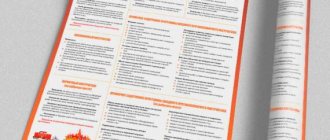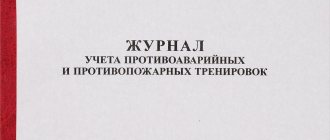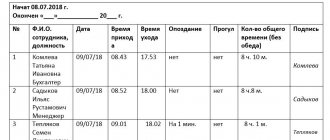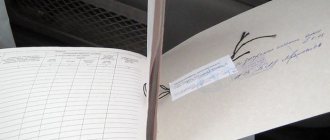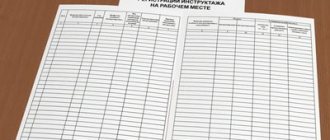After reading this article, you will learn why you need a fire safety briefing log (FS), what regulatory documentation introduces the need to keep a fire safety briefing log and establishes its form, and how to prepare it for work and fill it out correctly (make entries, correct errors).
Fire safety briefing log
Any aspects of training the organization’s personnel on industrial safety issues are regulated by the regulations on the organization of training and testing of knowledge on industrial safety. In him:
- all information about instructions is written down;
- forms of journals are given;
- rules for filling out and storing logs, including archival ones, are established.
Who fills out the briefing log?
The results of the briefing are entered into by the instructing person. These functions can be performed by:
- Head of the organization (introductory course);
- An employee appointed responsible for compliance with safety regulations at an enterprise or in a structural unit (all types of instruction);
- Manager of production work or personnel (all types, except introductory).
Responsibility can only be assigned to a person who has successfully completed training and certification in PTM. The frequency of the course is once every 3 years; for workers in explosion- and fire-hazardous industries, training is conducted annually.
Employee training
on safety measures in an organization or enterprise, regardless of what form of ownership they relate to, are mandatory .
The employer is obliged to organize training, practical and theoretical, and conduct certification on TB. Fire safety also falls into this category.
Instructing workers on fire safety in their field of activity includes the following steps:
- The employer organizes familiarization of employees with the rules, as well as changes and additions to them.
- The study of safety in technological processes involving the use of flammable and combustible liquids is being carried out.
- A practical lesson on the use of primary fire extinguishing agents is organized .
- The procedure for action in case of fire is being studied.
A program of lectures is being developed in these areas. Listeners get acquainted with:
- fire regulations;
- rules for maintaining industrial buildings and territories;
- requirements for production technology, including its features;
- the procedure for carrying out fire prevention measures and using taps, fire extinguishers, ventilation and detectors;
- the use of automatic installations and alarm systems.
Important! For convenience, all information is written down in notes. This will make it easier for the manager to navigate.
Magazine form
A sample of filling out the fire safety briefing log is given in Appendix 1 of the Order of the Ministry of Emergency Situations No. 645 (12.12.2007). The document is an A4 book, produced at a printing house or manually (for example, on a regular printer) in compliance with approved rules.
The book must contain the following information:
- Date of the event;
- Information about the person being instructed – full name, date of birth, profession (position);
- Full name of the employee who conducted the training;
- Type of instruction;
- Reasons for conducting training (unscheduled);
- Signatures of the instructor and persons who attended the course.
The number of journals is not regulated and is determined individually based on the number of staff. At his discretion, the manager can provide one document for the whole enterprise, for each structural unit, and even for a separate event. The most practical model is 1 book for introductory instruction and 1 or more for other types of training.
Why do you need a fire safety training log in the workplace?
Mastering the theoretical part of safety precautions at an enterprise is a prerequisite for admitting a newly arrived employee to his workplace. In addition to introductory training, other types of classes are provided for employees, depending on their length of service at the enterprise or other special conditions. There are a total of 5 types of training for staff:
- introductory;
- primary;
- repeated;
- target;
- planned.
It is unacceptable to treat filling out the instruction registration book as a mere formality. Indeed, in the event of an emergency at the enterprise, it will confirm that training sessions were conducted with employees. And any inspection by the fire department will first require a log.
The manager or person responsible for safety is responsible for the timeliness and correctness of filling out the log. The authorized employee must have perfect knowledge of the discipline being taught and have experience working at the enterprise in question. In addition, he is required to have personal qualities that will help ensure a safe environment in the enterprise.
Important! Often, upon arrival to a new position, an employee undergoes simultaneously training in fire safety and labor protection. In such a situation, appropriate entries in separate journals are necessary.
Preparing the journal for filling
Before keeping a fire safety log, make sure it meets the established requirements.
Firmware
The lacing instructions described below will help ensure convenient entry of results on all pages:
- Make holes (if there are none in the original form of the book);
- Pass a thin thread from the side of the title page; as lacing material you can use stitched nylon thread, twine, linen cord, etc.;
- Release the ends on the last sheet or back cover of the document;
- The ends must be at least 5 cm long to ensure complete freedom when turning pages.
Assurance
Fix the ends of the thread to the cover and apply a piece of paper on top containing the following information:
- Number of pages (sheets) of the document;
- Date of filing and fixing of the sticker;
- Information about the instructing person (full name, position/profession), as well as his signature.
Place the organization's seal on the dried piece of paper so that the imprint is present simultaneously on the sticker and the base (cover or sheet).
Numbering
The number must appear on each page. The counting is carried out from the title page or the first page with the table. Numbering can be done by hand, using a stamp or machine printing (put down immediately after printing).
Composition of information contained in the journal
The book is filled out in real time, simultaneously with the implementation of the event. The timing of the PIP is determined by the administration of the enterprise in accordance with existing standards. Obligations to meet deadlines are important for ensuring industrial safety even in the event of an emergency situation.
The responsible person must ensure that the information in the accounting book is complete and that there are no blots or erasures when filling out. There is no line numbering in the book, which is explained by keeping records of different types of PPI in one document. When entering text, skipping lines or spaces between entries are not allowed. If an incorrect text is entered, the line is crossed out and the correct entry is entered below.
The book contains data:
- Date of the PPI.
- Full name of the person being instructed.
- Year of birth of the person being instructed.
- Specialty, job title of the person.
- Type of PPI performed.
- Full name of the official conducting the FIR.
- Signatures of PPI participants. The document is used for internal accounting, which does not require signatures to be certified with a seal. Certification is only required for journal extracts provided to third parties upon request.
All required columns must be completed. The information should be brief and consistent with the column name. It is allowed to enter additional information as a note in the empty space of the fields. For example, when conducting a targeted or unscheduled PPI caused by special circumstances, indicate the reason for its conduct.
Filling out fire safety logs
After the training event, the instructor must enter the relevant information in all empty cells, sign, and also make sure that all persons being instructed sign.
Error correction
When filling out the fire safety briefing log, you are not immune from mistakes. If accepted, it is necessary:
- Cross out the entire line with one straight line;
- Make an o under the crossed out line, in the column for the date of the instruction and the instructor’s signature;
- Fill in the following blank line with valid information.
The color of the paste must be selected according to the requirements for document flow.
Often, mistakes made are discovered over time, when subsequent lines have already been filled out. In this case, a similar procedure is applied - the line with the incorrect entry is crossed out, and the correct information is entered in the nearest empty line. To make it easier to find the desired entry in the future, you can highlight the crossed out line with an underline or color.
What not to do?
When filling out the document it is not allowed:
- Leave blank lines;
- Make corrections, incl. with a proofreader, crossing out one letter, an eraser, a blade and other methods;
- Tear out the sheets and glue new ones in their place with the same number;
- Make temporary notes (with erasable pen, pencil, etc.).
Based on the results of the fire safety briefing, only the fire safety log is filled out. The use of a magazine for occupational safety and health is not allowed, even when training is carried out jointly under both programs.
Nothing can be pasted into the document; additional sheets of information can simply be stored inside the journal.
Filling procedure
To fill out, you must use the form established by Order No. 645. Using it, you can enter information about all types of briefings. At the same time, the legislator does not prohibit the use of such a form for each individual type of instruction.
It's easy to fill out the form. The algorithm includes several steps:
- Indicate on the cover the name of the institution, start and end dates.
- Enter the following information into the table:
- date of the PIP;
- Full name, year of birth, profession, position of the employee being trained;
- type of PPI (introductory, primary, repeated, unscheduled or targeted);
- Full name, position of instructor.
- The information is completed with the mandatory signatures of both participants in the process.
Entries must be made without allowing corrections. Blank lines between entries are not allowed. Line by line columns must be filled in without any gaps.
Storage and filing of the magazine in the archive
To protect it from external influences, place the book in a cover or store it in a folder. During breaks between training events, limit access to the magazine to unauthorized persons.
When all pages and lines are completed, mark the end date of the journal on the title page (it coincides with the date of entry on the last line). Next, the document is sent to the archive, the storage period is 10 years. From now on, access to the completed journal is prohibited for all unauthorized persons, including signed employees.
Now you know how to fill out a fire safety briefing log so that the inspectors of the Ministry of Emergency Situations and other supervisory and control authorities do not have any questions. Also, proper document maintenance will help to avoid or minimize administrative penalties in the event of emergencies or industrial accidents.
Responsibility for absence
The legislator considers the failure to conduct instructions and, accordingly, the absence of a logbook to be a violation of fire safety rules. Responsibility is defined in Art. 20.4 Code of Administrative Offenses of the Russian Federation.
Violation is punishable by a fine in the amount of:
- 150,000–200,000 rubles - for a legal entity;
- 6000–15,000 rudders - for an official;
- 20,000–30,000 rubles - for individual entrepreneurs.
Violation of fire safety rules during the introduction of a special fire regime increases the amount to:
- 200,000–400,000 rubles - for a legal entity;
- 15,000–30,000 rubles - for an official;
- 30,000–40,000 rubles - for individual entrepreneurs.
Full list
There is a set of magazines that must be present at the enterprise without fail.
- Registration following induction training. Includes information on the list of personnel representatives who have undergone appropriate training and become familiar with safety precautions.
- Registration of on-site briefings. Materials about employees who have undergone training organized by the responsible person are included. Completion is carried out by oral questioning in order to check the consolidated knowledge.
- Accounting for OT instructions. The document is handled by the relevant service or a separate specialist of the enterprise. For convenience, it is recommended to assign a unique number to each instruction.
- Accounting for the provision of instructions to personnel. Valid for each department, kept by the manager.
- Accounting for the assignment of a specific electrical safety group. Includes all employees who are not engaged in the maintenance of electrical installations. The results of the training check are recorded.
- Registration of accidents. Conducted in accordance with Resolution of the Ministry of Labor of Russia No. 73. Filling out is carried out during verification activities regarding the situations that have occurred. A responsible person who has a third electrical safety group is in charge.
- Accounting for testing skills and standards of work in special electrical installations. The results of inspections carried out for employees are recorded.
- Registration of induction training on fire protection. It is carried out with all employees who are hired for a vacancy. Responsibility for maintenance rests with the employee, who vouches for fire safety in the company as a whole.
- Accounting for training activities on labor protection. To prevent workplace injuries, workers must undergo regular training. Upon completion, a knowledge check is carried out.
- Logbook of primary fire extinguishing tools. Necessary for timely testing of equipment for operability. This is carried out by a competent fire service employee.
- Document on recording monitoring of labor conditions. Filled out on a regular basis.
- Accounting activities for inspections. According to current legislation, not only legal entities, but also individual entrepreneurs are required to maintain documents. This contains detailed information about all inspections and violations.
This is not the entire list of magazines formed at the enterprise, but the main directions are listed here.
Special magazines
In addition to the mandatory documents appearing in the field of labor protection, there are some special papers. Let's look at the most common of them.
Read more: Accounting for financial assistance to an employee
Accounting for the issuance of certificates
According to the Resolution of the Ministry of Labor of Russia, the Ministry of Education of Russia No. 1/29, management staff and specialists are obliged to undergo a special training program that covers the obligations for each employee.
Activities begin immediately after employment and must be completed during the first working month. The development of programs is carried out on the basis of industry, nature of work, and working conditions. The complete list is approved by the management team.
For personal convenience, employees working in the HR department often use a journal to record the issuance of occupational safety certificates. It is used to record information about all certificates that have been issued. The document is maintained by a responsible competent specialist.
Within the framework of Art. 197 of the Labor Code of the Russian Federation states that every employee has the right to free professional training. The apprenticeship agreement is drawn up under conditions that do not imply the separation of the employee from the production process.
- the number of certificates that were issued;
- control of their provision, tear-off coupons;
- features relating to electrical workers;
- data on copies issued to management;
- information on permits to work in hazardous conditions.
Although the document does not belong to the list of mandatory documents, its use is recommended.
Regarding labor protection orders
Another special document is the log of orders related to labor protection. It helps to systematize all information and improve the work process in terms of increasing the level of security. It is recommended to obtain this document at your site, workshop or department.
It must contain a certain number of instructions, orders regarding internships, permission to work independently, and assignment of responsible persons. It is maintained in a single copy in accordance with the general procedure.


